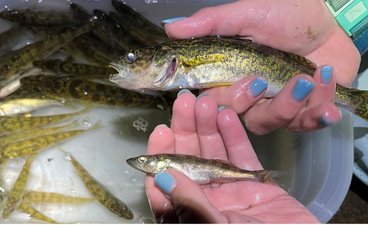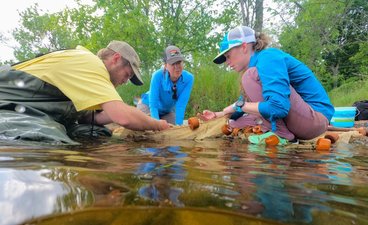by Denver Link
Minnesota’s state fish is threatened by an aquatic invasive species, potentially inducing public health concern. The beloved walleye holds significant cultural and economic importance in Minnesota, but zebra mussels cause large scale changes that impact the food web. Water Resources Science graduate student Denver Link seeks to understand how zebra mussels impact food sources for walleye populations in Minnesota lakes.

Named for their flashy adaptation, walleye reside in offshore areas that have dark and cool water. The distinctive walleye eye creates advantageous feeding conditions in those areas. Zebra mussels, however, alter lake environments that are important for walleye. After introduction to a lake, zebra mussels quickly cover rocks, docks, boats, and other hard surfaces. Smothering the surfaces in dense colonies, the mussels filter large proportions of phytoplankton from the water column. Decreases in phytoplankton abundance significantly hinder food availability for walleye prey in offshore areas. The ecosystem alteration fostered by zebra mussels diminishes offshore energy resources for the walleye food web.
With zebra mussels introduced, the nearshore regions of lakes become significant sources of energy for the walleye food web. Lower levels of phytoplankton allow sunlight to penetrate deeper into the water column, increasing nearshore area of the lake. Plants and animals in nearshore zones support the base of the walleye food web in this altered system.
Despite mercury regulation successfully decreasing atmospheric deposition in the past thirty years, mercury remains in the lake sediment. Coincidentally, mercury is introduced to the food web in nearshore lake regions through microbial processes. Nearshore energy reliance increases the chance for mercury to enter the walleye diet in zebra mussel invaded systems. Walleye caught in lakes invaded with zebra mussels possesses higher risk for unsafe mercury eating levels.
Denver and his team have visited over twenty Minnesota lakes that were invaded or uninvaded with zebra mussels. In collaboration with the Minnesota Department of Natural Resources, the team collected fish, macroinvertebrates, and zooplankton for stable isotope analysis. Ratios of carbon and nitrogen isotopes in animal tissues allow for the quantification of nearshore energy reliance in walleye populations. To address potential public health concern, fish tissue was sent to the United States Geological Survey Mercury Research Laboratory in Madison, WI, for total mercury analysis. Nearshore reliance and mercury concentrations will be compared between lakes invaded and uninvaded with zebra mussels. The team will be able to infer food web energy shifts in walleye food webs due to zebra mussel invasion.

Results of this study will help inform fisheries managers about the impact of zebra mussels on walleye food webs. The crew hopes the results will advise fish consumption advisories for lakes invaded with zebra mussels. "Aquatic invasive species have profound impacts in lakes. Prevention of aquatic invasive species remains the most effective combatant. Always make sure you check your boats, kayaks, or aquatic equipment for hitchhiking plants or animals," said Link.